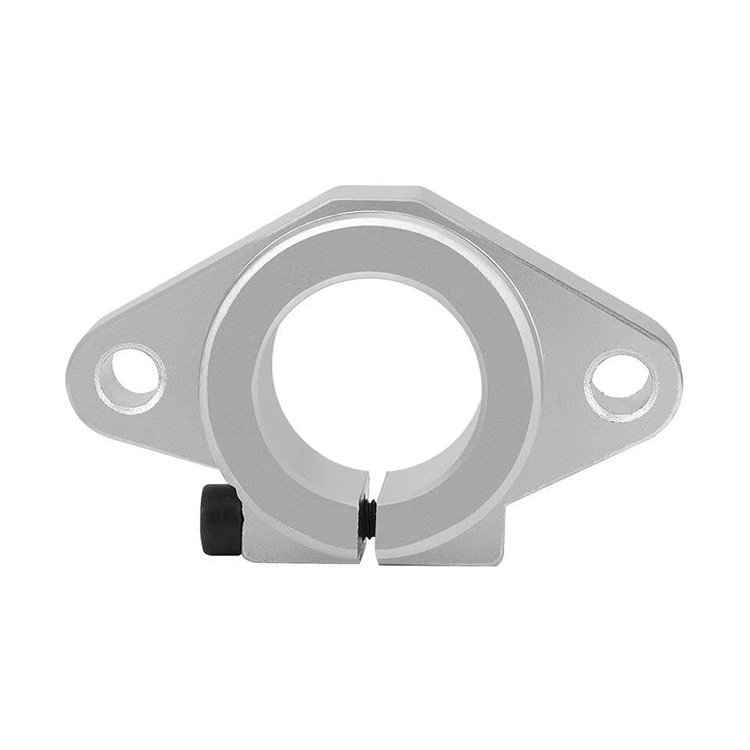In the realm of linear motion systems, guide shaft supports play a critical role in ensuring the stability, accuracy, and longevity of linear guides. These components are designed to securely hold and align guide shafts, enabling smooth and precise linear motion in a wide range of applications. From industrial automation to medical devices, guide shaft supports are indispensable for achieving reliable performance. This article provides a comprehensive overview of guide shaft supports, including their types, features, selection criteria, and maintenance tips, based on real-world data and applications.
What Are Guide Shaft Supports?
Guide shaft supports are mechanical components used to secure and align guide shafts in linear motion systems. They work in conjunction with guide shafts, linear bearings, and bushings to form a complete linear guide mechanism. These supports are designed to withstand radial and axial loads, ensuring the stability and precision of the system.
Key Functions of Guide Shaft Supports
- Support and Fixation: Provide a stable base for guide shafts, preventing misalignment and vibration.
- Load Bearing: Designed to handle both radial and axial loads, ensuring durability under stress.
- Alignment: Maintain the precise alignment of guide shafts, critical for smooth linear motion.
Types of Guide Shaft Supports
Guide shaft supports come in various designs to suit different applications and installation requirements. Below are the most common types:
1. Flange-Type Supports
- Application: Used when the guide shaft is perpendicular to the mounting surface.
- Advantages: Easy to install and provides strong support for vertical shafts.
2. Square-Type Supports
- Application: Suitable for installations where the guide shaft is parallel to the mounting surface.
- Advantages: Compact design and versatile for horizontal applications.
3. Set Screw-Type Supports
- Application: Ideal for simple installations requiring cost-effective solutions.
- Advantages: Easy to install and offers good value for money.
4. Thickened Support-Type
- Application: Designed for applications requiring higher radial load capacity.
- Advantages: Enhanced stability and durability under heavy loads.
5. Open-Type Supports
- Application: Used when frequent disassembly of the guide shaft is required.
- Advantages: Prevents damage to the shaft during installation and removal.
6. Compact-Type Supports
- Application: Suitable for installations in confined spaces.
- Advantages: Space-saving design without compromising performance.
7. End-Fixed-Type Supports
- Application: Used for guide shafts subjected to high axial loads.
- Advantages: Provides strong axial support and prevents shaft movement.
8. Split-Type Supports
- Application: Ideal for applications requiring frequent disassembly and reassembly.
- Advantages: Easy to install and remove without damaging the shaft.
9. Guided-Type Supports
- Application: Used in applications requiring precise radial positioning.
- Advantages: Ensures accurate alignment and reduces vibration.
10. Cast-Type Supports
- Application: Suitable for general-purpose applications with cost constraints.
- Advantages: Economical and widely applicable.
Applications of Guide Shaft Supports
Guide shaft supports are used in a wide range of industries and applications, including:
1. Industrial Automation
- Example: In robotic arms, guide shaft supports ensure precise movement during pick-and-place operations.
2. Medical Devices
- Example: In imaging systems, guide shaft supports provide stable and accurate linear motion for scanning components.
3. Semiconductor Manufacturing
- Example: In wafer handling equipment, guide shaft supports ensure smooth and precise movement of delicate components.
4. Food and Beverage Industry
- Example: In packaging machines, guide shaft supports enable consistent and reliable operation in harsh environments.
Selection Criteria for Guide Shaft Supports
When selecting guide shaft supports, consider the following factors:
1. Installation Orientation
- Vertical Shafts: Use flange-type supports.
- Horizontal Shafts: Use square-type supports.
2. Load Requirements
- Radial Loads: Choose thickened support-type or end-fixed-type supports.
- Axial Loads: Opt for end-fixed-type supports.
3. Assembly and Disassembly Needs
- Frequent Disassembly: Use open-type or split-type supports.
- Permanent Installation: Use set screw-type supports.
4. Environmental Conditions
- General Use: Carbon steel supports with black oxide coating are cost-effective.
- Corrosive Environments: Stainless steel or nickel-plated supports are recommended.
- Lightweight Applications: Aluminum supports with anodized coating are ideal.
5. Space Constraints
- Compact Spaces: Use compact-type supports.
6. Positioning Requirements
- Radial Positioning: Use guided-type supports.
- Axial Positioning: Use square-type supports with positioning holes.
Installation and Maintenance Tips
1. Installation
- Alignment: Ensure proper alignment of guide shafts and supports to prevent binding or uneven wear.
- Handling: Avoid direct contact with hands during installation to prevent corrosion (especially for black oxide-coated supports).
- Lubrication: Apply anti-rust oil after installation and periodically during use.
2. Maintenance
- Regular Inspection: Check for signs of wear, corrosion, or damage.
- Cleaning: Keep the supports clean and free from debris.
- Lubrication: Reapply anti-rust oil periodically to maintain performance.
Common Issues and Solutions
1. Corrosion
- Issue: Black oxide-coated supports are prone to rust in humid environments.
- Solution: Regularly apply anti-rust oil and avoid exposure to moisture.
2. Misalignment
- Issue: Improper alignment can cause uneven wear and reduced performance.
- Solution: Use precision alignment tools during installation.
3. Wear and Tear
- Issue: High loads or frequent use can lead to wear.
- Solution: Choose supports with higher load capacities and perform regular maintenance.
Conclusion
Guide shaft supports are essential components in linear motion systems, providing the stability and precision needed for smooth and reliable operation. By understanding the different types, selection criteria, and maintenance practices, you can ensure optimal performance and longevity of your linear motion systems. Whether you’re working in industrial automation, medical devices, or semiconductor manufacturing, guide shaft supports are a critical part of your success.









